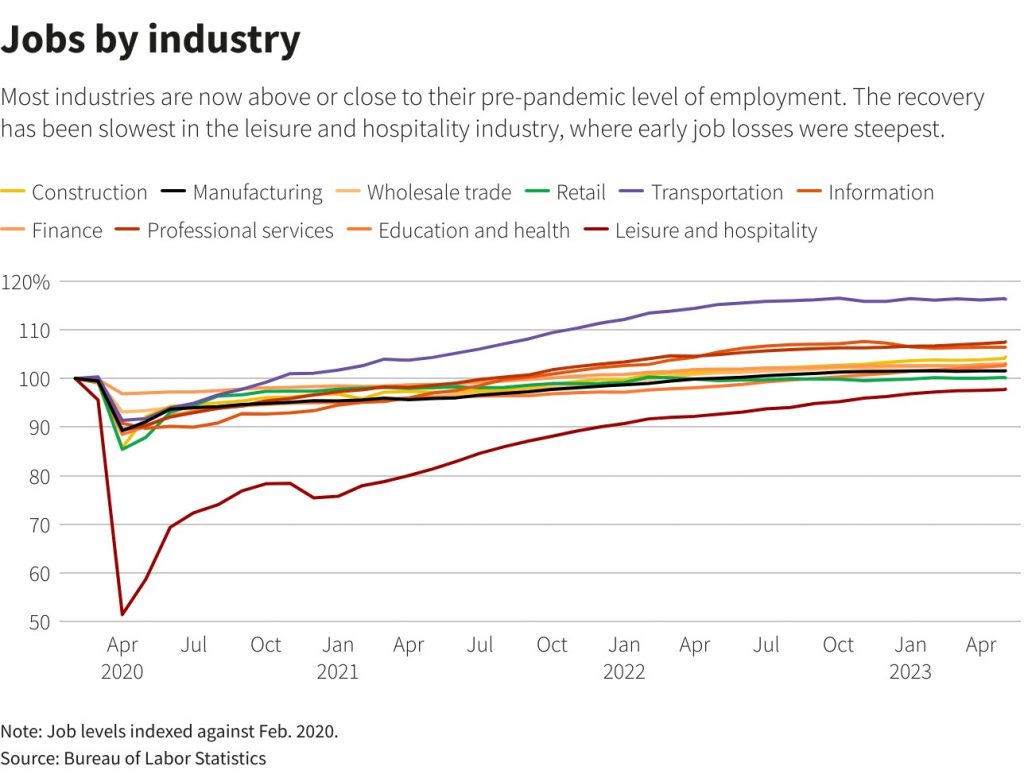New York July 7 2023: The U.S. economy added the fewest jobs in 2-1/2 years in June, but persistently strong wage growth pointed to still-tight labor market conditions that most certainly ensure the Federal Reserve will resume raising interest rate later this month.
The Labor Department’s closely watched employment report on Friday also showed 110,000 fewer jobs were created in April and May, indicating that higher borrowing costs were starting to dampen businesses’ appetite to continue boosting headcount. There was also a jump in the number of people working part-time for economic reasons last month, in part because their hours had been reduced due to work slack or business conditions.
Nevertheless, the pace of job growth remains strong by historical norms and was further evidence that the economy was far from a dreaded recession.
“The labor market appears to be cooling but not fast enough to prevent another tap on the brakes from the Fed on July 26,” said Sal Guatieri, as senior economist at BMO Capital Markets in Toronto.
Nonfarm payrolls increased by 209,000 jobs last month, the smallest gain since December 2020, the survey of establishments showed. Economists polled by Reuters had forecast payrolls rising 225,000. The economy needs to create 70,000-100,000 jobs per month to keep up with growth in the working-age population.
While the higher paying industries such as technology and finance are purging workers, sectors like leisure and hospitality as well local government and education are still catching up after losing employees and experiencing accelerated retirements during the COVID-19 pandemic.
Government employment increased by 60,000, boosted by a 59,000 rise in state and local government payrolls. Government employment remains 161,000 below its pre-pandemic levels. Healthcare payrolls rose by 41,000 jobs, reflecting increases in hiring at hospitals, nursing and residential care facilities as well as home health care services.
Construction employment jumped by 23,000. The housing market is showing signs of revival after being battered by a surge in mortgage rates. The Fed has raised its policy rate by 500 basis points since March 2022 when it embarked on its fastest monetary policy tightening campaign in more than 40 years.
There were also increases in professional and business services employment. Leisure and hospitality payrolls increased 21,000. Employment in the industry remains 369,000 below its pre-pandemic levels.

Average hourly earnings rose 0.4% last month after climbing by the same margin in May. In the 12 months through June, wages increased 4.4%, matching May’s advance.
Annual wage growth remains too high to be consistent with the Fed’s 2% inflation target.
U.S. stocks opened lower. The dollar fell against a basket of currencies while U.S. Treasury yields rose.
The household survey from which the unemployment rate is derived showed strong employment gains. That more than offset an increase in the number of people entering the labor force. As a result, the unemployment rate slipped to 3.6% in June from a seven-month high of 3.7% in May.
But the number of people employed part time for economic reasons increased by 452,000 to 4.2 million, partially reflecting an increase in those whose hours were cut due to slack work or business conditions.










